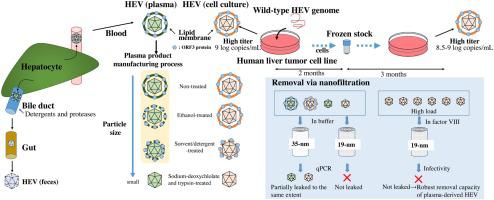Journal of Virological Methods ( IF 3.1 ) Pub Date : 2021-07-22 , DOI: 10.1016/j.jviromet.2021.114244 Shoji Ideno 1 , Takamasa Inoue 1 , Kadue Takahashi 1 , Takeru Urayama 1 , Hideki Maeno 1 , Kaoru Takeuchi 2 , Kaoru Sakai 1

|
Safety evaluation for the hepatitis E virus (HEV) is required for plasma fractionation products. Plasma-derived HEV (pHEV) is quite unique in that it is associated with a lipid membrane, which, when stripped during manufacturing processes, induces morphological changes in the virus, making it difficult to select proper HEV phenotypes for clearance studies. We developed a convenient system for the preparation of a high titer cell culture-derived HEV (cHEV). In this system, PLC/PRF/5 cells transfected with the wild-type HEV genome generated lipid membrane-associated cHEV for a long period even after cryopreservation. We also examined how this lipid membrane-associated cHEV can be used to verify the robustness of pHEV removal via 19-nm nanofiltration. Sodium-deoxycholate and trypsin (NaDOC/T) treatment not only dissolved lipid but also digested membrane-associated proteins from pHEV and cHEV, making the resulting cHEV particle smaller in size than any pHEV phenotypes generated by ethanol or solvent-detergent treatment in this study. In both 19-nm and 35-nm nanofiltration, cHEV behaved identically to pHEV. These results indicate that cHEV is a useful resource for viral clearance studies in term of availability, and the use of NaDOC/T-treated cHEV ensured robust pHEV removal capacity via 19-nm nanofiltration.
中文翻译:

经不同化学处理的细胞培养衍生的戊型肝炎病毒的表型特征:在纳滤去除病毒中的应用
血浆分离产品需要对戊型肝炎病毒 (HEV) 进行安全性评估。血浆来源的 HEV (pHEV) 非常独特,因为它与脂质膜相关,当在制造过程中剥离脂质膜时,会引起病毒的形态变化,从而难以选择合适的 HEV 表型进行清除研究。我们开发了一种方便的系统,用于制备高滴度细胞培养衍生的 HEV (cHEV)。在该系统中,转染野生型 HEV 基因组的 PLC/PRF/5 细胞即使在冷冻保存后也能长时间产生脂质膜相关的 cHEV。我们还研究了如何使用这种与脂质膜相关的 cHEV 来验证通过 19 nm 纳滤去除 pHEV 的稳健性。脱氧胆酸钠和胰蛋白酶 (NaDOC/T) 处理不仅溶解脂质,还消化来自 pHEV 和 cHEV 的膜相关蛋白,使所得 cHEV 颗粒的尺寸小于本研究中由乙醇或溶剂清洁剂处理产生的任何 pHEV 表型. 在 19 nm 和 35 nm 纳滤中,cHEV 的行为与 pHEV 相同。这些结果表明,就可用性而言,cHEV 是病毒清除研究的有用资源,并且使用 NaDOC/T 处理的 cHEV 通过 19 nm 纳滤确保了强大的 pHEV 去除能力。

























 京公网安备 11010802027423号
京公网安备 11010802027423号